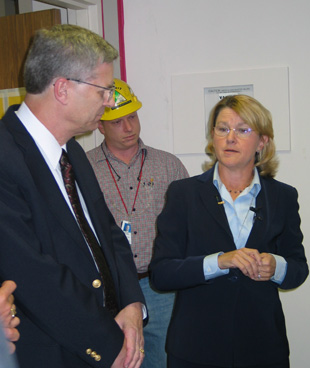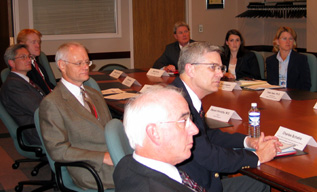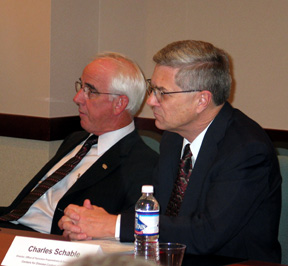 |
Charles Schable of the CDC and Pat Lenaghan of The Nebraska Medical Center visit the construction site of the Biocontainment Unit. |
Donning a hard hat, Charles Schable toured the construction site of the Nebraska Biocontainment Unit, a specialized 10-bed area in University Tower designed to contain an illness in the event of a terrorist event, or a naturally occurring, highly infectious agent such as monkeypox or SARS (Severe Acute Respiratory Syndrome).
“Nebraska, again, has shown it has the foresight and leadership to handle emergencies,” said Schable, director of the Office of Terrorism Preparedness and Emergency Response at the Centers for Disease Control and Prevention (CDC) and Agency for Toxic Substances and Disease Registry (ATSDR) in Atlanta. “This will be a first-class establishment.the risk of an agent getting out is essentially zero.”
The Biocontainment Unit is expected to be operational in January 2005, said Pat Lenaghan, nurse coordinator of the Biocontainment Unit for The Nebraska Medical Center. Construction began July 19 on the unit’s five negative-pressure, HEPA filter isolation rooms. This isolation unit has its own air handling system. The special air handling system, the HEPA filters and UV lights in each room ensures that no infectious particles get out of the rooms and into the hospital or community.
“We thought it was better to put all 10 beds in one unit, rather than spreading them around in several different areas of the hospital,” Lenaghan said.
 |
Charles Schable of the CDC leans forward while listening to a presentation on the new Biocontainment Unit. |
Specially trained staff with special access cards will operate the area on the seventh floor of University Tower. The U.S. Department of Health and Human Services’ Health Resources and Services Administration (HRSA) and The Nebraska Medical Center are partners in funding the project. “As far as we know, it’s the first hospital-based biocontainment unit developed as a state resource,” Lenaghan said.
 |
Richard Raymond, M.D., left, of the state’s Health and Human Services System, and Charles Schable of the CDC listen to UNMC leaders discuss their work in bioterrorism preparedness. |
“When the SARS outbreak happened in Toronto last year, a Biocontainment Unit such as ours would have been ideal,” said Philip W. Smith, M.D., medical director of the Biocontainment Unit. “Fifty percent of the SARS cases in Toronto were hospital workers, so if they could have isolated the patient in a Biocontainment Unit such as ours, it would have resulted in fewer people dying or getting sick.
“This is a specialized environment with specialized staff. It’s good for the patient and protects hospital workers and the public by containing the agent and limiting its exposure,” Dr. Smith said. “Because of the role UNMC and The Nebraska Medical Center play in the community it’s likely that we would receive these infectious patients. Now we have a better plan to take care of them.”